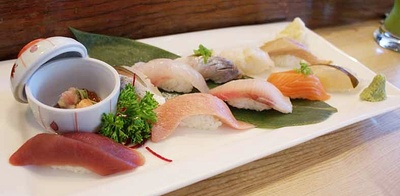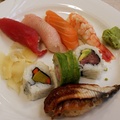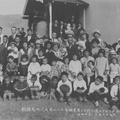“Did I struggle in the East Coast? Not at all.”
Toshi-san stands behind the counter, and with a disarming smile asks, “Is there anything that you don’t like?”
Toshi Sushi is located three doors down from the Japanese American National Museum in Little Tokyo. The man behind the counter preparing the sushi is the owner of this establishment, Toshihiko Seki. Known as “Toshi-san” to all of his patrons, he made his move from Connecticut to Los Angeles just three years ago.
“Among the restaurants in the New England area (includes 6 states: Connecticut, New York, Massachusetts, New Hampshire, Vermont, and Rhode Island), my restaurant was rated by ZAGAT with 26 points. Being rated number one amongst hundreds of restaurants… I was definitely pleased, you know, to be recognized by experts who really understand what’s good. But in this restaurant, I don’t put it [the award] on display. It doesn’t matter that I’ve received an award in the past, right? The most important thing is how things are ‘now’.”
Toshi-san was 19 years old when he came to America in 1981. He has been living is the States for 28 years now.
“My grandfather ran a sushi restaurant in Shinagawa, Tokyo, and I grew up helping out at the restaurant, so I naturally learned about sushi. Even if I couldn’t make the sushi itself, I knew how to do all of the preparations. The first place I worked at in America was called Katsura Restaurant in San Diego. I worked the sushi counter and kitchen there, and they sponsored me for my Green Card…”
San Diego provides great weather and a safe neighborhood, and is generally considered a nice place to live in, but it seems it lacked enough excitement for a young Toshi-san, still in his early 20s. Although he spent his weekends hanging out in Los Angeles, he eventually “got bored” of California and left.
“I received a [job] offer from New York around ‘87. That restaurant in New York was one of those private-type restaurants, like Matsuhisa in Los Angeles. There, I worked with highly skilled chefs and was blessed with a fantastic Oyakata (master chef) who taught me how to do really good work. After that, a friend of mine said he was going to open up a restaurant in Connecticut, so in 1990 I went to Connecticut, and in ‘97 I became independent.”
Toshi-san moved from New York (where authentic Japanese food is abundant, much like in Los Angeles) to Connecticut—a very conservative area, despite its proximity to neighboring New York. In other words, he was moving to the East Coast countryside.
“When I went to Connecticut in 1990, I think there were only about 20 [Japanese restaurants] there. But during my 17 years there, it grew to over 100 restaurants, though there aren’t many that are Japanese-owned.”
Perhaps more important than being honored with the highest ZAGAT rating amongst New England restaurants is the love his restaurant received from the locals in the Connecticut area.
“Even the customers who didn’t know a thing about sushi at first… after the 17 years that I worked in Connecticut, near the end, all of my long-time customers were able to tell what good sushi is supposed to taste like. I’m really happy about that. Some of the kids, who used to come eat with their families as five year olds… they came back again after they were all grown up. I thought that was extraordinary. When those kids came back to celebrate their wedding, or the birth of their own children, it really made me think, you know, ‘Wow, I’ve really been working in this place for a long, long time.’”
In Connecticut, the customers are mostly Caucasians. Through connections with his customers, Toshi-san’s restaurant held an annual charity for the local Children’s Cancer Research Center. Due to his close involvement with the community, it was quite a bit of news when Toshi-san announced his departure to California in 2006. “They told me that I really contributed to the community. Even the governor of Connecticut came to the restaurant before I left.”
It had been awhile since Toshi-san lived on the West Coast, and on top of that, he was settling down in Los Angeles for the first time. In the beginning, he worked for another restaurant as a sushi chef while starting up his own sushi catering business.
“It’s fine working for someone else’s restaurant, but don’t we all dream to own our own businesses? I wanted to serve things like maguro (tuna) zuke (soy sauce marinade) and kobu-jime (kelp marinade)—especially since other restaurants just don’t serve these types of dishes. For my private catering business on weekends, I would take my sushi showcase with me [to the venue] and I’d gain a great deal of satisfaction for doing my own work. If you have a restaurant, people can always come back, but with catering, you only get one shot [at satisfying the customer], right? That made it a lot of fun. Even nowadays, I try my best to work in some catering events whenever I can.”
As I listen to Toshi-san’s story, he continues to deliver a splendid combination of sushi and fine Japanese dishes onto my plate. The Edo-mae (traditional Tokyo style) nigiri: a kobu-jime hirame (flounder) with such delicate flavors—perfect on a freshly cleansed palate—and the unbelievable juiciness of the maguro zuke. The three styles of tamagoyaki (Japanese omelette) are simply terrific: one mixed with aonori (green laver) and grilled Isobe-yaki style, and the other two enclosing ume (pickled plum) and yama imo (mountain yam), respectively, for a tart and sweet combination...Even the fresh wakame (seaweed) delivered straight from the local fish mart, when combined with Toshi-san’s signature miso soup, is exquisite. “Simplicity is the best”—perhaps this is the definition of the true Japanese Flavor.
“If you trace back a hundred years in the history of sushi—we’re talking about an age without any refrigerators or ice. Yet they were still making sushi, so they had to prepare it in a special way, right? Kobu-jime, zuke, making oshi-zushi (boxed/pressed sushi), or wrapping [the sushi] in leaves… these are the origins [of sushi]. It’s amazing that they were able to do it without refrigerators.”
Perhaps affected by his extensive stay on the East Coast, Toshi-san says he is used to American customers more so than Japanese customers. So, do the American customers fully appreciate the authenticity of his sushi?
“The people who get it—they really do get it, even more so than the average Japanese person. I can see it, watching from behind the counter. I’ll say [to an American], ‘try the kobu-jime,’ and when they do, I can see that they sense the subtle aroma and flavor of the konbu (kelp)…
“There’s been an influx of Asian-fusion restaurants in the past 10 years or so. It’s definitely a trend, and I know that it’s good in its own way… but in the end, I think it’s important to go back to the roots. That’s what I believe in. I think that’s why I insist on things like the zuke, and so on and so forth… When I prepare hirame, I just feel there’s nothing better than a kobu-jime, plain and simple with some salt and lemon. I think it’s good to have a restaurant that can offer something like that.”
During the interview, several fish dealers stopped by the restaurant for lunch. They are regulars here so none of them place specific orders. They simply accept whatever is served. This is where the pros dine—this is Toshi’s restaurant.
“Since I’m in L.A. now, there’s much more access to Japanese things compared to the East Coast, so I really try to take advantage of it. I want my customers to taste the food as close as it gets to the source. Like with the fresh wakame—the fish mart owner would give me a call saying, ‘We just got some fresh ones in; do you want any?’ and if I say, ‘Yes, please,’ they’ll bring it over to me right away. That sort of stuff was unthinkable when I was in the east [coast].”
When asked about why he decided to open shop in Little Tokyo, he scratches his head and says, “I’m not really sure.” Of all places in the Los Angeles area, where Japanese cuisine is now widespread, he chose to settle at the origin, in Little Tokyo—a fitting place for this chef, who in his 28 years of experience in America has become a sort of “Sushi Missionary.” With greater access to Japanese ingredients here in L.A., what will his skills have in store for us now?
Toshi-san’s restaurant, Toshi Sushi, just opened its doors last November.
Watch a video interview with Toshi on YouTube >> (Japanese only)
© 2009 Yumiko Hashimoto








